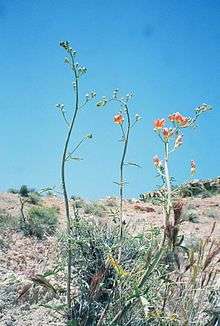Sphaeralcea gierischii
| Sphaeralcea gierischii | |
|---|---|
 | |
| Scientific classification | |
| Kingdom: | Plantae |
| (unranked): | Angiosperms |
| (unranked): | Eudicots |
| (unranked): | Rosids |
| Order: | Malvales |
| Family: | Malvaceae |
| Subfamily: | Malvoideae |
| Genus: | Sphaeralcea |
| Species: | S. gierischii |
| Binomial name | |
| Sphaeralcea gierischii N.D.Atwood & S.L.Welsh | |
Sphaeralcea gierischii, Gierisch's globemallow[1] or Gierisch mallow, is a rare species of flowering plant in the mallow family, Malvaceae. It is native to the western United States, where it is known only from Utah and Arizona.[2] It was described in 2002.[3]
There are only five known occurrences, with 90% of the population located within Mohave County, Arizona. It is threatened by open-pit mining for gypsum. The single occurrence in Utah is also threatened by off-road vehicle use and dumping.[2]
Since 2011, Red Butte Garden's Conservation Department in Salt Lake City, Utah, has been conducting germination, propagation, and transplant studies at a site in Arizona, just South of St. George, UT. The studies are meant to assess the feasibility of reintroducing S. gierischii to reclaimed gypsum mine tailings.[4]
In 2012, it was proposed as an endangered species under the Endangered Species Act.[5] In 2013 it was granted endangered status. [6]
Ecology
Sphaeralcea gierischii is a perennial plant. It produces clumps of dark reddish purple stems up to about a meter tall with a few bright green, lobed leaves. The flowers have petals up to 2.5 centimeters long. They are orange, or sometimes described as "grenadine".[2]
Associated species include creosote bush, blackbrush, saltbush, yucca, ragweed, ephedra, rabbitbrush, prairie-clover, James' galleta, cheesebush, Anderson's desert thorn, prickly pear, indigo bush, and cliffrose.[2]
The plant is nearly an obligate gypsophile, mainly limited to the gypsum soils of the Kaibab Limestone; it has also been seen on limestone soils. The gypsum is sought after and extensively mined in the area by a process that involves removing the top layer of rock, mining the gypsum-rich deeper layers, and filling the pit with the rubble of the top layer. This process is very destructive to the local habitat.[2]
References
- ↑ "Sphaeralcea gierischii". Natural Resources Conservation Service PLANTS Database. USDA. Retrieved 25 November 2015.
- 1 2 3 4 5 Sphaeralcea gierischii. NatureServe. 2012.
- ↑ Atwood, N. D. and S. L. Welsh. (2002). Overview of Sphaeralcea (Malvaceae) in southern Utah and northern Arizona, USA, and description of a new species. Novon 12(2) 159-166.
- ↑ http://www.redbuttegarden.org/current_projects
- ↑ Gierisch mallow (Sphaeralcea gierischii). US Fish and Wildlife Service Species Profile.
- ↑ http://www.gpo.gov/fdsys/pkg/FR-2013-08-13/pdf/2013-19385.pdf
